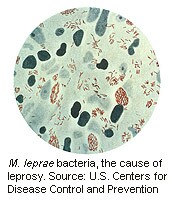
WEDNESDAY, Dec. 16 (HealthDay News) — Seven genes associated with increased susceptibility to leprosy have been identified by scientists in Singapore and China.
The researchers, who analyzed more than 10,000 DNA samples from leprosy patients and healthy people in China, said their discovery highlights the important role that the innate immune response plays in the development of leprosy.
“Though leprosy is not common, the discoveries have significant ramifications for chronic infectious disorders and for host-pathogen interactions in other more prevalent mycobacterial diseases such as tuberculosis,” Dr. Edison Liu, executive director of the Genome Institute of Singapore, said in a news release from the institute.
“The discovery of these genes is a major breakthrough for research in leprosy and infectious diseases in general, and will be significant in the early diagnosis and development of new treatments,” study co-leader Jianjun Liu, Human Genetics Group Leader at the institute, said in the release.
The study appears online Dec. 16 in the New England Journal of Medicine.
The genes are: CCDC122, C13orf31, NOD2, TNFSF15, HLA-DR, RIPK2 and LRRK2.
Leprosy is a chronic infectious disease caused by the bacterium Mycobacterium leprae. The disease, which mainly affects skin and peripheral nerves, is rare in developed countries, but remains a major public health problem in many developing countries. According to the World Health Organization, 254,525 new cases of leprosy were diagnosed in 2007.
In regions where leprosy is common, many people are exposed but only a few become infected and develop clinical signs of leprosy, which indicates that only certain people are susceptible to the disease.
More information
The U.S. National Library of Medicine has more about leprosy.

